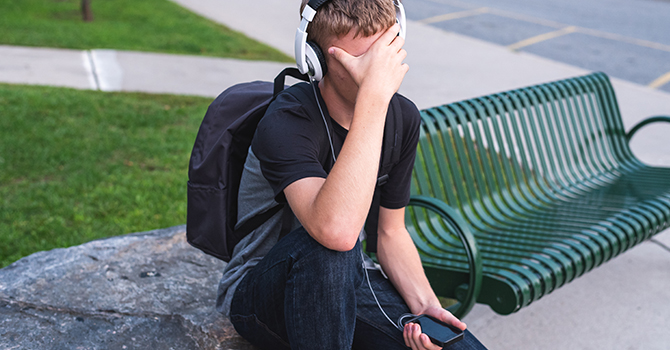Bridging the Gap: Connecting Public Health and Public Schools to Support Students

Laura Hollander, MPH '19
Students face a number of challenges that make it difficult to do well in school and lead happy, healthy lives.
Many Michigan public schools are under pressure to improve student grades and test scores. But currently the connection between student grades and student health is under-recognized by the Michigan Department of Education. Schools are already doing a lot of work in the classroom to improve student academics,1 but in order to truly improve education, Michigan schools must improve student health. To improve student health, schools should include public health programs about mental and behavioral health in classrooms.
Public middle schools should consider how public health programs can support students. Middle school is an important time for child development. Teenagers’ brains seek immediate rewards.10 This leads teenagers to try new things, some of which pose a threat to health. While exploration is natural, habits that start in middle school can be hard to break.5 Additionally, many behaviors that affect mental health, including alcohol and drug use and sexual activity, first appear when children are in middle school.8 For these reasons, middle school teachers and personnel should always consider student health.
Middle schools can improve health outcomes by making classrooms more nurturing. Children spend more time at school than anywhere else, expect for their beds.3 Schools also influence children’s self-esteem. Students who feel supported at school and by their teachers have fewer mental illnesses.7 These students are more likely to say no to drugs alcohol and sexual activity.12
Middle school children develop best when they feel nurtured, are connected to friends and teachers, and can make their own choices.11 Public health programs that allow students to make choices, connect struggling students, support teachers, and make middle schools more nurturing can improve student health and school grades.2,4,6,9 Just as public schools can educate students about health, public health can provide schools with programs that improve student health and educational outcomes.
Lobbyists, policy makers, and citizens must encourage local, state, and federal agencies to provide schools and teachers with the resources to integrate public health interventions into public schools.
For more suggestions on how public health models can be used to support public schools, please see my topic brief, Bridging the Gap: Connecting Public Health and Public Schools to Support Students.
References
- 21st Century Education Commission. (2017). The best education system for Michigan’s success. Lansing: State Board of Education.
- Akos, P., & Shields Kurz, M. (2016). Applying Hope Theory to support middle school transitions. Middle School Journal, 47(1), 13-18.
- Blackman, K. F., Powers, J. D., Edwards, J. D., Wegmann, K. M., Lechner, E., & Swick, D. C. (2016). Closing the Gap: Principal Perspectives on an Innovative School-Based Mental Health Intervention. The Urban Review, 245-263.
- Corrigan, P. W., & Watson, A. C. (2002). Understanding the impact of stigma on people with mental illness. World Psychiatry, 1(1), 16-20.
- Dahl, R. (2004, June). Adolescent brain development: A period of vulnerabilities and opportunities - Keynote Address. Pittsburgh, Pennsylvania, USA: Psychiatry and Pediatrics.
- Downing, J., & Bellis, M. A. (2009). Early pubertal onset and its relationship with sexual risk taking, substance use and anti-social behavior: A preliminary cross-sectional study. BMC Public Health, 9(446).
- Kuperminc, G. P., Leadbeater, B. J., & Blatt, S. J. (2001). School social climate and individual differences in vulnerability to psychopathology among middle school students. Journal of School psychology, 39(2), 141-159.
- Reinke, W. M., Stormont, M., Herman, K. C., Puri, R., & Goel, N. (2011). Supporting children's mental health in schools: Teacher perception of needs, roles, and barriers. School Psychology Quarterly, 26(1).
- Vichich, J., & Paladino, J. (2019, March 21). TRAILS program - Independent Study Interview. (L. Hollander, Interviewer)
- Walker, D. M., Bell, M. R., Flores, C., Gulley, J. M., Willing, J., & Pual, M. J. (2017). Adolescence and reward: Making sense of neural and behavioral changes amid the chaos. Journal of Neuroscience, 37(45), 10855-10866.
- Wang, M. T., & Peck, S. C. (2013). Adolescent educational success and mental health vary across school engagement profiles. Developmental psychology, 49(7), 1266-76.
- Wormington, S., Anderson, K. G., Schnedier, A., Tomlinson, K. L., & Brown, S. A. (2014). Peer victimization and adolescent adjustment: Does school belonging matter? Journal of School Violence, 15(1), 1-21.
- View more stories about mental health.
- Read more articles written by Michigan Public Health alumni.
- Support research and education at Michigan Public Health.
ABOUT THE AUTHOR
 Laura Hollander is a 2019 graduate of the University of Michigan School of Public
Health and holds a master’s degree in Health Behavior and Health Education. She is
looking forward to moving back to Brooklyn, New York, where she hopes to use her degree
to promote both health and social justice programs. In her free time, Hollander loves
to chat about Bruce Springsteen, play ice hockey, and pet dogs.
Laura Hollander is a 2019 graduate of the University of Michigan School of Public
Health and holds a master’s degree in Health Behavior and Health Education. She is
looking forward to moving back to Brooklyn, New York, where she hopes to use her degree
to promote both health and social justice programs. In her free time, Hollander loves
to chat about Bruce Springsteen, play ice hockey, and pet dogs.
